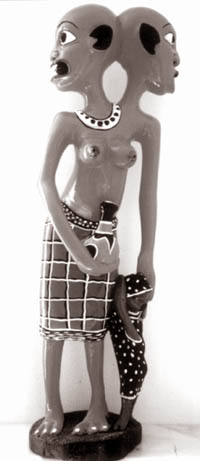|
DAILY NEWS ONLINE |
|
|
|
OTHER EDITIONS |
|
|
|
|
|
|
|
|
|
OTHER LINKS |
|
|
|
|
|
|
 |
Africa Remix: contemporary art of a continent
Organised by theme into three sections - History and Identity, City and Country, Body and Soul "Africa Remix" comprises some 300 works by 80 artists from 25 African countries. Simon Njami, the exhibition's curator, selected internationally renowned artists such as Cheri Samba, George Lilanga, Frederic Bruly Bouabre, Pascale Marthine Tayou and Yinka Shonibare, as well as lesser-know or even unknown artists whose works reflect the exuberance of the art scene in Africa and the entire African Diaspora. Over the past two decades, African artists have travelled world wide, organised multiple exhibitions and residencies, and met with other artists, collectors and art critics, thereby generating the conditions for a fertile hybridisation between their respective cultures and investigations carried out in the name of contemporary art. "Africa Remix" echoes these mutations. The exhibition's name evokes a revisited Africa that mixes its cultural symbols with Western icons and media - an Africa that differs greatly from the usual cliches concerning this vast continent. The artistic panorama presented by the exhibition raises various questions. What is African art today? To what degree is the term "contemporary", generally associated with the artistic production of industrialised countries, appropriate? What bonds do these works create with African tribal art? And which facet of African do these artists portray? While the recycled objects are a reminder that in poor economies, everything can be reused, they also serve as a rejoinder to wealthy countries, turning around both their products and their wasteful policies. As Hazoume says. "The Europeans took away our masks and left us their trash bins. I turn their bins into masks; like that, we can keep our masks for ourselves". This technique of diverting community symbols dominates the exhibition's History and Identity section. Aime Ntakiyica, from Burundi, offers visitors a series of self-portraits in which he poses in European national costumes, while Fernando Alvim, from Angola, presents a large canvas with the words: "We are all post-exotic". Indeed, what is the history that post-colonial Africa can lay claim to ? Does the question of identity not inevitably raise the issue of authenticity? The artists answer these questions by underscoring the disparities inherent any inter-cultural approach between their continent and Europe. Built using waste and rubbish collected in townships, the plane created by Titos flies over the exhibition's second theme, City and Country, like a shortcut between the rural exodus and the chaotic explosion of big cities. This issue is illustrated by various photographs and videos, as though the realistic impact of these techniques was a prerequisite for conveying the lives of people, whether farmers or improvised urbanites. In contrast to this social precariousness, Congolese artist Bodys Kinguelez has imagined "The City of Sete in 3009", a cheerful architectural utopia that resembles an opulent version of Kinshasa sprawled along the Mediterranean Sea... It's in the last section, Body and Soul, that ancient Africa emerges. It seems that individuals, with their genealogy, spirituality and sexuality, endure the deepest tensions between modernity and tradition. In the pieces presented by N'Dilo Mutima (Angola) and Eileen Perrier (Ghana), faces morph back into masks and bodies are reduced to their grotesque remains (Ernest Weangai's Costume du Negre) or used in bizarre sacrifices (Loulou Cherinet). In fact, the older artists predominate in this section, those whose childhood was marked by the rituals and beliefs of a bygone era, as evidenced by Jackson Hlungwani's Tiger Fish (South Africa): a long piece of animist wood that recalls a crocodile or a funerary boat of sorts. Yet far from presenting a jaded vision of the world, their pieces are often humorous retorts to today's era, from Tanzanian George Lilanga's Shetanis (grotesque spirits that mock our human failings) to Bruly Bouabre's eccentric awareness (Cote d'Ivoire), which likens missiles to a growth similar to porcupine spines. "Africa Remix" beckons visitors to explore an Africa that has been revisited and rectified by its artists, who are our guides - guides in the truest sense, since they lead us to a place we could not have reached on our own, into a dynamic and rich Africa that radiates vitality. Co-produced by the Museum Kunst Palast in Dusseldorf, the Hayward Gallery in London, the Centre Georges Pompidou in Paris and the Mori Art Museum in Tokyo, this exhibition is also sponsored by Afrique en Creations, a department of the French Association for Artistic Action (AFAA), with the aim of promoting African artists internationally. Eric Girard - Actualite En France. |
|
|
 Inaugurated in Dusseldorf and also shown in London, the exhibit
"Africa Remix: Contemporary Art of a Continent" is set to run in Paris,
at the Georges Pompidou Centre, from 25 May to 8 August 2005.
Inaugurated in Dusseldorf and also shown in London, the exhibit
"Africa Remix: Contemporary Art of a Continent" is set to run in Paris,
at the Georges Pompidou Centre, from 25 May to 8 August 2005. 